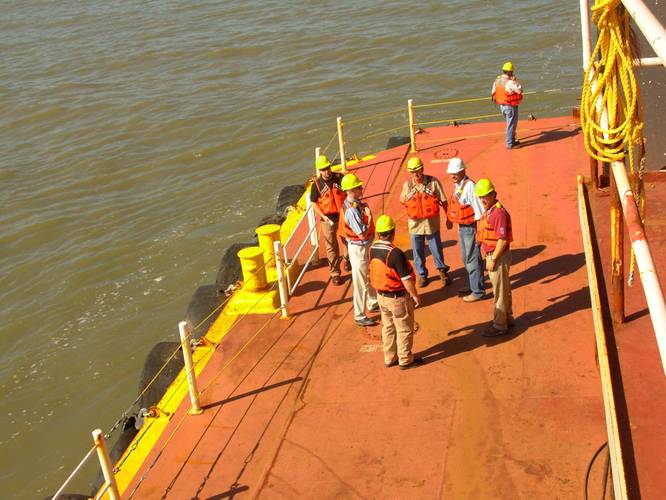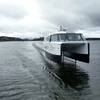SafeOps: Dredging Industry Full Ahead
Safety experts both in and out of the maritime industry have for years been urging companies to restructure their organizational charts and erase the traditional division between Safety and Operations Departments in favor of disseminating safety responsibilities throughout operational divisions. This internal merger is often sold as an effective strategy for improving employee communications, fostering greater safety leadership throughout a company, and reducing the rate of injuries, as well as the high costs that come with them.
Great Lakes Dredge & Dock Company (GLDD), one of the largest dredging companies in the country, joined the growing list of companies to have embedded their Safety Department into Operations in 2007 in an attempt to strengthen efforts to lower incident rates. Five years later, the experiment has been declared a success.
“It has proven itself to be one of the best things that we have done,” said Gail Johnson, the Divisional Safety, Health, and Environmental Manager (DSHEM) for GLDD’s Clamshell Division.
But leaders at GLDD say their successes are far from guaranteed, and that the most important part of the process is what happens after the organizational chart is redrawn.
SafeOps at GLDD
GLDD first began to reflect on the role their Safety Department in 2005 after losing out on several larger projects because of annual incident rates in the double-digits. “We were low cost and technically the soundest, but when they looked at our safety record, we were lacking,” said Steve O’Hara, Vice President of Safety and Incident and Injury Free for GLDD. “We thought we had a pretty sophisticated Safety Department, but we saw at that time that something there was missing.”
GLDD responded with a series of programs designed to put greater emphasis on safety in Operations. But when the programs’ initial success began to wane, the Illinois-based company realized that more needed to be done to change how employees understood safety and their role in it.
The old organizational chart went under the knife. Corporate and site-specific employees in the Safety Department were told that they now reported to Divisional and Site Managers, and employees working on projects across the company learned that safety expectations had been added to their job descriptions.
Safety: an ongoing process
Since 2007, GLDD has taken many additional steps to strengthen their safety culture, making it difficult to determine how much impact reorganization had directly. But GLDD is currently enjoying an Total Recordable Incident Rate of less than two, a number which is reached by dividing the number of incidents in a period by the number of hours worked and then multiplying the total by 200,000. And the Total Lost Time Injury Rate continues to hover below one.
With lower incidents have come significant savings for the company in the form of renegotiated insurance premiums, fewer claims costs, and improved employee retention. At the same time, GLDD has secured more and larger projects in part because of their strong safety record. On that list is the Chevron-operated Wheatstone LNG Project in Australia, which GLDD joined in February of this year. “We have an extra feather in our cap now with our recordable incident rate about 20% of what it was when we started,” O’Hara said.
According to Johnson and O’Hara, one organizational change directly related to the 2007 decision, is a shift away from Safety employees being “safety cops” and safety itself a barrier to production. “Before this all came about we were definitely the old traditional safety role,” Johnson said. “It was the cop. It was: go out, look for problems, and write up people for failure to perform safely.”
But Safety employees working under Operations leaders meant the two groups spent more time than ever before working together—in meetings, on conference calls, and on-site. And with increased interaction came a better understanding of each other’s work and role in safe operations.
Building Sustainable Change
At first glance, the successes GLDD has seen as a result of merging their Safety and Operations Departments may appear to be the result of the reorganization alone. But safety leaders within the company said the real change came from the way the 2007 transition was rolled-out across the company.
Merging Safety with Operations and the strategies for introducing the change on-site were part of a larger Transformative Safety effort at GLDD developed through a partnership with the Illinois-based safety consultancy, the Hile Group. The goal was to move the company toward a process approach to safety, where safety initiatives are developed and implemented by the field and safety professionals are a resource for the front line and help facilitate field-developed processes.
Since 2007, the goals of Transformative Safety have also led GLDD to put a greater focus on the leadership role of their Safety Leadership Teams, redesign its New Hire Orientation program, develop a Job Safety Analysis process with booklets capturing standard tasks, revamp the structure of Project Launch Meetings, and, most recently, develop a safety rule book written and vetted by the front line.
According to Johnson, one key feature in the implementation of the departmental merger was the focus on face-to-face safety discussions. In the months following the merger, Safety employees travelled from dredge-to-dredge, site-to-site to talk, in part, directly with front-line crew about the new organizational chart. The visits gave Safety employees the opportunity to demonstrate interest in learning from Operations crew and inject stronger safety conversations into where and when the work is actually done.
“You are trying to overcome the production mentality of over 100 years, so people have to see it [dedication to Operations-led safety] in your eyes, see it on your face, hear it in your voice,” Johnson said. “Having that face time as a group with people who are at the deck level—they can see how we are working together to accomplish a task and can see the production guys out there asking questions about safety—that is part of the whole passion. They have to see people interacting with Safety and asking questions.”
GLDD made sure, Johnson said, that Safety employees were on-site during “the good, the bad, and the indifferent” to help teach crew to integrate safety into day-to-day communications and reinforce the message that a task is only done right if it is done safely.
Safety: Leading from the Top
At the same time, the interactions happening on site were being reinforced and encouraged by the highest levels of the company. The demonstrated belief executives had in the processes and their efforts to model the type of discussions and behavior the company was aiming for helped GLDD get through some of the initial hesitancy from employees in both departments.
“It is a whole lot easier, and your success is much higher, when you have the commitment from the top leader,” Johnson said. “I had a very strong VP and that, for me, was key. If the VP wasn’t into it, it could have been disastrous.”
But perhaps most important to the successful integration of Safety and Operations at GLDD is the commitment the company has fostered in individuals, from the front line to the executive offices, to working safely themselves and ensuring that others have the knowledge, resources, and organizational support needed for everyone to go home safe.
“Companies often try different things, but when it gets difficult they quit instead of recognizing that that difficulty or challenge is what is going to make them stronger.” Johnson said. “If anyone thinks that transforming your company is going to be easy—it is not. It is not a 9:00 to 5:00 thing, but the rewards at the end are huge.”
(taken from the June 2012 MarineNews print edition)
Anjanette Riley is a performance consultant for the safety consultancy the Hile Group. On the web: www.hilegroup.com / Email: [email protected]















